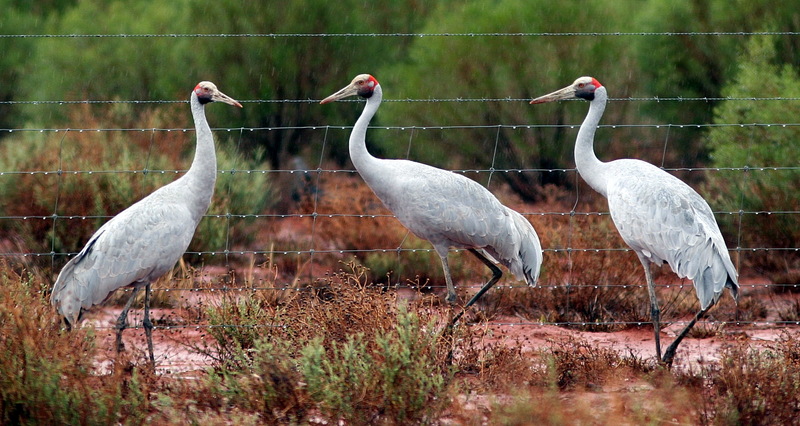Brolga
From Wikipedia, the free encyclopedia
[Photo] Brolga, Grus rubicundus, Eulo, Australia. Date July 2006. Author Glen Fergus http://commons.wikimedia.org/wiki/User:Glen_Fergus
The Brolga (Grus rubicunda), formerly known as the "Native Companion", is a bird in the crane family. The bird has also been given the name "Australian Crane", a term coined in 1865 by well-known ornithological artist John Gould.
The Brolga is a common gregarious wetland bird species in tropical and eastern Australia, well known for its intricate mating dance.
Taxonomy and naming
When first described in 1810, the Brolga was misclassified as Ardea, the genus that includes the herons and egrets. It is in fact a member of the Gruiformes ??? the order that includes the crakes, rails, and cranes, and a member of the genus Grus. In 1926 the Royal Australasian Ornithologists Union made Brolga, a popular name derived from Gamilaraay burralga, the official name of the bird.
The Brolga is closely related to other cranes like the Sarus Crane of Australia and Southeast Asia, with which it can easily be confused. However the Sarus' red head colouring extends partly down the neck while the Brolga's is confined to the head. Additionally, in Australia the range of the Sarus is limited to a few scattered localities in northern Australia, compared to the more widespread distribution of the Brolga. The bird is also related to the Old World Common Crane, and, more distantly, to the Blue Crane of South Africa.
Description
The full-grown Brolga is a tall, mid-grey to silver-grey crane, 0.7 to 1.3 m (3.3-4.3 feet) high, with a wingspan of 1.7 to 2.4 m (5.6 to 7.9 ft), and a broad red band extending from the straight, bone-coloured bill around the back of the head. Juveniles lack the red band. Adult males average at a little under 7 kg (15.4 lbs), females a little under 6 kg (13.2 lbs).
Distribution and habitat
Brolgas are widespread and often abundant in north and north-east Australia, especially north-east Queensland, and are common as far south as Victoria. They are also found in southern New Guinea and as rare vagrants in New Zealand and the northern part of Western Australia. The population is estimated at between 20,000 and 100,000 and is not considered to be threatened. The International Crane Foundation began a captive breeding population with three pairs of wild Brolga which were captured in 1972. Brolga are non-migratory but do move in response to seasonal rains.
Ecology and behaviour
Brolgas are gregarious creatures; the basic social unit is a pair or small family group of about 3 or 4 birds, usually parents together with juvenile offspring, though some such groups are nonfamilial. In the non-breeding season, they gather into large flocks, which appear to be many self-contained individual groups rather than a single social unit. Within the flock, families tend to remain separate and to coordinate their activities with one another rather than with the flock as a whole.
Diet
Brolga are omnivorous and eat a variety of wetland plants, insects, invertebrates, and small vertebrates such as frogs. They also eat wetland and upland plants, seeds, mollusks, and crustaceans. Northern Austalian populations of Brolga are fond of the tubers of the bulkuru sedge which they dig holes to extract but this is not available south of Brisbane.
Mating and breeding
Brolgas are well known for their intricate mating dances. The dance begins with a bird picking up some grass and tossing it into the air, catching it in its bill, then progresses to jumping a metre into the air with outstretched wings, then stretching, bowing, walking, calling, and bobbing its head. Sometimes just one Brolga dances for its mate; often they dance in pairs; and sometimes a whole group of about a dozen dance together, lining up roughly opposite each other before starting.
In the breeding season, which is largely determined by rainfall rather than the time of year, the flocks split up and pairs establish nesting territories in wetlands. In good habitat, nests can be quite close together, and are often found in the same area as those of the closely related but slightly larger Sarus Crane. The nest is a raised mound, built by both sexes, of sticks, uprooted grass, and other plant material sited on a small island, standing in shallow water, or occasionally floating. If no grasses are available, mud or roots unearthed from marsh beds are employed. Sometimes they make barely any nest at all, take over a disused swan nest, or simply lay on bare ground.
A pair of spotted or blotched white eggs are most common, but sometimes the clutch is one or three, laid about two days apart. Both birds incubate and guard the young. Hatching is not synchronised, and takes about 30 days. The chicks hatch covered in grey down and weighing about 100 g. They can leave the nest within a day or two, have body feathers within 4 or 5 weeks, and are fully feathered after three months, and able to fly about two weeks after that. When threatened, chicks hide and stay quiet while the parents perform a broken-wing display. The parents continue to guard the young for up to 11 months, or almost two years if they do not re-nest.
http://en.wikipedia.org/wiki/Brolga
| The text in this page is based on the copyrighted Wikipedia article shown in above URL. It is used under the GNU Free Documentation License. You may redistribute it, verbatim or modified, providing that you comply with the terms of the GFDL. |
|

